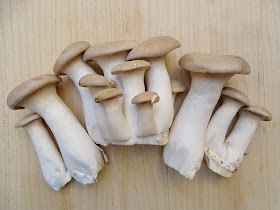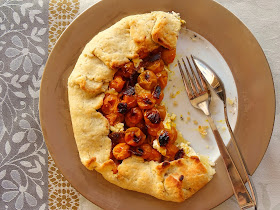For a compulsive person with an inability to say no – that would be me – the holidays offer a number of traps that my hubby refers to as self-inflicted wounds. This year the problem was acute. Dinners for 8, 16, and 13 so far, with one to come for 12 on New Year’s Eve. And something like 400 decorated cookies – for the neighborhood party, my children and grandchildren, and one of those dinner parties. What was I thinking?
Then in the run-up to sending those cookies to my grandchildren, I discovered that my cache of cookie tins was down to zero. I stopped in at my local Container Store, where they always have a good supply, and discovered... nothing. A couple of very small tins, and a couple of very large ones, but none of the Goldilocks size that holds exactly three dozen cookies.
I grabbed a nice young man who was working there and challenged him.
“You sure?” he said.
“Pretty sure,” I said.
“Well, let’s go check. There might be some in a couple of other places around the store.” But no. Only more of the very big ones, which would mean baking more cookies, and the very thought of restarting the baking process had me ready to weep.
We discovered some square tins, which I thought might do, and some middle-sized tins that my helper swore to me were the middle-sized tins they’d always had. Still, when you’ve bought as many of these things as I have, you develop an eye for the right size. But how to prove it? I had a lightbulb moment.
“I’ll call my daughter-in-law,” I said. “She might have some of the old ones that we can measure.”
Sure enough, she had some. “So tell me what the measurements on them are. I’ll need height and diameter,” I said. The mathematician in me had awakened and figured to compare the volumes of these various tins. Even with different shapes, I could know how many cookies would fit.
“Hold on,” she said. “I have to find a measuring tape.” There followed a lot of rustling around, and a raised voice as she asked the darling children what they had done with the measuring tape.
“She’s looking,” I said to my helper. Finally, sounding slightly frustrated, my DIL said, “Well, I can’t find the measuring tape. So do you have a Metrocard [NYC Transit card]?”
“Uh, yes...,” I said, as I dug through my purse. Then she added brightly, “It’s the same height as a Metrocard.”
“Ok,” I said, “but I also need the diameter...” And that’s where the train derailed. In desperation, I bought a few of the faux-middle-sized tins and headed out. Amazingly, on my way home, the cookie gods smiled at me. My friend Elaine called to say that she’d just been to Michael’s where they had cookie tins on sale. The exact right size. A Christmas miracle.
And at that point, I also knew what to get my son and daughter-in-law for Christmas: tape measures.
* * *
On one of my many trips through the grocery store this season, I happened upon a display of Italian delicacies, and found a recipe for an hors d’oeuvre that sounded unusual, festive, and delicious. I was right on all counts. You get a full range of tastes – from the sweetness of the grapes to the salty pancetta and the slightly bitter, garlicky flavor of the shallots. The cool creaminess of the ricotta adds a great visual and textural contrast to the grape/pancetta/shallot mix. So it’s not just tasty – it’s also gorgeous.
Because of the slicing and dicing, this is a tiny bit tedious in the making; but if you enlist your mate or another helper in dicing the pancetta and slicing the grapes, it can all be done in an hour. Mise en place will again be very helpful, so start with the slicing and dicing. Once you begin cooking, the process moves along pretty quickly – less than 25 minutes on the stove. And while you’re cooking, your “helper” can make the little toasts.
Crostini of Ricotta with Red Grapes
Adapted from Central Market, Austin, Texas.
Serves 8-10.
Ingredients
1 baguette, cut diagonally in ½-inch thick slices
Extra-virgin olive oil
1 large garlic clove (optional)
10-12 ounces of ricotta (as fresh as you can find)
1-2 heaping tablespoons of honey (the KG fave is acacia honey)
Kosher salt and freshly ground black pepper
4 ounces pancetta, sliced to thickness of bacon and cut in ½-inch dice*
1 pound seedless red grapes, sliced in half lengthwise
4 shallots (about 6 ounces), thinly sliced
¼ cup of dry white wine
1 tablespoon balsamic vinegar (plain or fruit-flavored balsamic; I used fig balsamic)
Garnish: 1 bunch basil, chiffonade
*Kitchen Goddess note: Pancetta is essentially Italian bacon, but the two products aren’t made the same. Bacon is cured with salt, then smoked and sliced. Pancetta is cured with salt, black pepper, and spices and rolled into a cylinder. It is never smoked. Most of the time, you’ll find it in your grocer’s deli area, where you’ll have to have it sliced to order. For this recipe, you’ll want to get it sliced thin,
but not wafer thin. Tell the deli guy/girl you want it about the thickness of bacon.
Directions
Preheat the oven to 350º or set it on broil. Brush one side of the baguette slices with olive oil, lay them on a baking sheet, and bake them for 10 minutes, or run them under the broiler for 45-60 seconds, until lightly toasted. You’ll have to keep an eye on the broiler version – they can burn in a heartbeat when you’re not looking. Brush the other sides and repeat to get both sides lightly toasted. The KG also rubs one side with a clove of fresh garlic, but that’s up to you. Set the crostini aside.
In a small bowl, whisk together the ricotta, the honey, and salt/pepper to taste. Don’t be stingy with the pepper – it adds great flavor. Set aside the flavored ricotta.
In a large skillet over medium heat, cook the diced pancetta until golden. Remove from the pan with a slotted spoon, leaving the fat in the pan. To the fat, add the shallots and sauté for 3 minutes, until they appear soft.
Add the grapes, stir together well, and increase the heat to medium-high. Leave the grapes and shallots to cook undisturbed for 5 minutes, then stir occasionally as the mixture cooks for another 5-6 minutes. The finished grapes are prettiest if they experience some browning, so try to get the cut side of the grapes exposed to the bottom of the skillet as much as possible. If the shallots start to burn, remove them to the bowl or plate with the pancetta, or push them to the side of the skillet.
Pour the wine into the skillet and stir well to scrape up any bits of pancetta/shallot/grape from the bottom. Add the pancetta back to the pan, and continue to cook, stirring, until the liquid in the pan has reduced to almost nothing. Remove the pan from the heat and stir in the vinegar.
Serve the grape mixture atop crostini that have been spread with the ricotta, and sprinkled with chiffonade of basil. The Kitchen Goddess likes to serve the grape mixture and the ricotta in separate bowls, so that guests can assemble the crostini themselves, but you can also assemble them and serve on a tray or plate.
By the way, this should go very well with champagne or another dry sparkling wine.
Happy New Year to you all!!






















































